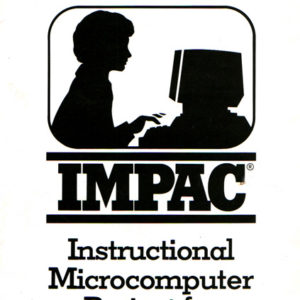calsfoundation@cals.org
Instructional Microcomputer Project for Arkansas Classrooms (IMPAC)
The Instructional Microcomputer Project for Arkansas Classrooms (IMPAC) was an innovative program that helped make emerging microcomputer technologies a key component of education in Arkansas. Influential across the nation, IMPAC was cited for excellence by Electronic Learning, Instructor Magazine, Pro Education, Information Week, the National Governors Association, the Congressional Office of Technology Assessment, Nelson B. Heller & Associates, and the Southwest Education Development Laboratory.
A number of Arkansas educators made significant efforts in laying a foundation for the use of microcomputers in instruction, as well as providing for technical support and workshops for teachers and school administrators, K–12. New technologies of the 1980s included networking microcomputers, the progression toward online resources, computer-assisted instruction and multimedia, and instructional management software for microcomputers. Also, advances in computer memory, microprocessor speed, and administrative applications outside of mainframe computers were slowly forming the basis for a new industry. Martha Ann Jones, then director of the Arkansas Community Foundation, and Donna Kay McLarty had studied the Minnesota Computing Consortium (MECC) and the Houston School District’s groundbreaking uses of microcomputer technologies and MECC software in elementary schools. Thomas “Mack” McLarty, then head of Arkansas Louisiana Gas Company (Arkla), and Walter Smiley, then board chair and chief executive officer of Systematics, Inc., a Little Rock (Pulaski County) producer of financial software, urged Governor Bill Clinton to undertake a similar venture. On February 22, 1983, fifteen Arkansas business leaders met at Systematics, Inc., and decided to invest $225,000 in an experimental effort to determine if the anticipated advances in managed networked microcomputer technologies could be used for computer-assisted instruction in grades 3–8. Soon after that meeting, the Arkansas Commission on Microcomputer Instruction (ACMI) was established under Act 528, which was signed into law by Governor Clinton on March 17, 1983.
The legislature first funded an experimental phase involving programs at twenty-six district sites. After their evaluation was completed under a grant from the Winthrop Rockefeller Foundation, ACMI established a nonprofit company, IMPAC Learning Systems, Inc. The company was formed with the consent of the Arkansas Department of Education (ADE) in order for IMPAC to contract for the development of educational software that would be owned by the state, as well as to provide hardware, support services, and professional development for teachers. The beginning focus was on basic skills in all of the school districts in Arkansas.
Phase I (1983–1992) consisted of research and software development, instructional programs in basic skills for students in grades 3–8 in language arts and mathematics (as well as distance learning in foreign languages), teacher professional development, and ninety Vocational Education Basic Skills programs. There were 527 program installations. During Phase II (1992–1997), reading and science were added to the basic curriculum, school district technology planning guidelines were developed, and about ninety microcomputer labs designed by IMPAC were installed by inmates working in an IMPAC and Arkansas Correctional Industries Partnership. Phase III (1997–2002) saw the development of more diversified projects at both elementary and high school levels. There were 427 program installations during Phase II and Phase III.
Between 1983 and 2002, the ACMI implemented, through IMPAC, 954 projects in eight different program areas. Between 1983 and 1992, approximately 70,000 students and 3,000 teachers were reached through 314 local school district computer-based instructional programs on a yearly basis. Between 1993 and 2002, approximately 80,000 students and 4,000 teachers were reached through 390 projects related to managed basic skills instruction, multimedia in social studies and science, writing labs, and the use of the Internet. There were also 250 school district contracted programs implemented.
In 1982, the K–12 ratio of students to computers was 275:1. By 1993, that ratio had become 10:1; by 2000, the ratio was 5.3:1. That achievement moved Arkansas into the top ten states in student access to computers. Arkansas had moved from 1,569 instructional computers in the classroom in 1982 to 87,830 in 2000. Furthermore, evaluations indicate that, in general over a nine-month period, students involved in IMPAC projects in mathematics, language arts, and reading gained two to three months, or thirteen to seventeen percentile points, on standardized tests. During its lifespan, IMPAC earned $6,455,032 from contracted services and $974,289 in software royalties from schools in other states; in addition, the program received $934,291 in grants from various sources. Most of the funds went toward the cost of programs and services in schools. Overall program savings for state and school district projects was 27.1 percent ($23,600,000) less than commercial bid cost, including software developed and provided free to the schools of Arkansas.
Leadership contributions included those provided by Walter Smiley, Mack McLarty, and Dr. Don Roberts (director of the Arkansas Department of Education in 1983). Jodie Mahoney, David Malone, Allen Gordon, John Miller, Carolyn Pollan, and Stanley Russ helped formulate Act 528 and steered it through the legislative process. Dr. Jerry Linnstaedter, chairman of the Department of Mathematics and Computer Science at Arkansas State University (ASU), was the longest-serving member of both the commission and the IMPAC board.
A memorandum of understanding between the Arkansas Department of Education, the ACMI, and the IMPAC Learning System, Inc., board of directors was signed on June 1, 1998, and facilitated the transition of IMPAC programs and services to school districts and state government agencies on June 30, 2002. IMPAC continued through 2002, when its business division (software, infrastructure planning and implementation, and support services) was sold to a for-profit company, IMPAC Technology Solutions. After all obligations were met, IMPAC Learning Systems Inc. set up an advised endowment fund at the Arkansas Community Foundation. The initial endowment fund of $1,485,000 has averaged $1,580,000 annually, and, as of July 1, 2010, the fund has provided more than $600,000 in grants to help support the annual Hot Springs State Technology Institute for educators, Arkansas Educational Television Network (AETN) Technology Teacher Institutes, and graduate fellowships in educational technology at Arkansas State University (ASU) and the University of Arkansas at Little Rock (UALR).
On June 7, 1999, the Arkansas Senate commended the ACMI and the IMPAC staff for “their efforts and success in advancing the use of educational technology in Arkansas schools.” IMPAC was presented the annual National Technology Leadership Award in December 2000 in Washington DC, and the IMPAC program director, Dr. Cecil McDermott, was presented the annual Arkansas Society for Technology in Education Leadership Award on June 18, 2003, and was inducted into the Arkansas Academy of Computing on April 11, 2008.
For additional information:
IMPAC Archival Records. William Jefferson Clinton Presidential Library, Little Rock, Arkansas.
“IMPAC: One State’s Approach on Focusing Technology on the Task of Improving Basic Skills.” Electronic Learning 5 (May/June 1986): 17–20.
“Riding the Waves of Change—The IMPAC Story (1983–2000).” Arkansas Commission on Microcomputer Instructions Commemorative Report. Little Rock: Arkansas Commission on Microcomputer Instructions, 2000.
“Welcoming Technology: The Arkansas Story.” Austin, TX: Southwest Educational Development Lab, 1994.
Cecil McDermott
Conway, Arkansas
 IMPAC Senate Citation
IMPAC Senate Citation  IMPAC Logo
IMPAC Logo  Cecil McDermott
Cecil McDermott 




Comments
No comments on this entry yet.